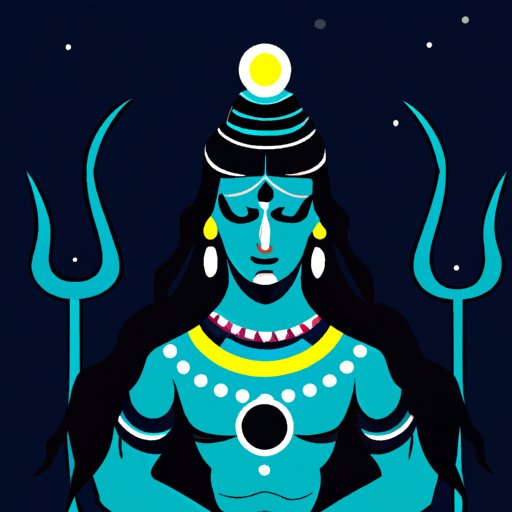I. Introduction
Shiva is one of the most complex and intriguing figures in Hindu mythology. As one of the major deities in the Hindu pantheon, understanding Shiva’s meaning and significance can offer a deeper understanding of Hindu spirituality and culture. In this article, we will explore the many facets of Shiva, including his role in creation mythology, the different forms and attributes associated with him, and the symbolism behind his physical forms and teachings. We’ll also discuss the relevance of Shiva’s teachings in modern-day Hindu practice, and how worshiping him can help individuals achieve inner peace and enlightenment.
II. Exploring the Meaning and Significance of Shiva in Hindu Mythology
Shiva is one of the three major gods in Hinduism, along with Vishnu and Brahma. He is often referred to as the destroyer, but this term can be misleading. In Hinduism, destruction is a necessary part of the cyclical process of creation, preservation, and renewal. As a god who embodies both death and rebirth, Shiva is believed to bring about change and transformation in the world.
According to Hindu creation mythology, Shiva is responsible for the destruction of the world at the end of each cycle, which paves the way for a new creation. He is often depicted as a yogi, meditating in the Himalayas, and is associated with asceticism, self-control, and detachment from worldly desires.
In Hindu temples and homes, Shiva is often worshiped in statue form, as well as through the chanting of mantras and the performance of ritual acts. Devotees may offer flowers, fruit, and other offerings to the god, as well as engage in meditation and prayer.
III. The Many Faces of Shiva: A Comprehensive Look into Hinduism’s Most Complex Deity
Shiva is often considered to be the most complex of all Hindu deities, and his interpretations vary greatly across different Hindu traditions. Some Hindus see Shiva as the destroyer of evil, while others view him as a god of fertility and regeneration. Still, others consider him to be a supreme being who transcends all finite attributes.
One of the most fascinating aspects of Shiva’s character is his multitude of forms and attributes. Shiva is often depicted in many different ways, including as a warrior, a lover, and even as half-man, half-woman. He is often associated with animals such as the bull and the serpent, and is sometimes shown wearing tiger or leopard skin.
Two of the most iconic representations of Shiva are Nataraja, the Lord of the Dance, and Ardhanarishwara, the half-man, half-woman form. Nataraja represents the cosmic dance of creation and destruction, while Ardhanarishwara embodies the unity of male and female principles, as well as the interconnectedness of all things.
IV. Unpacking the Symbolism of Shiva and Its Relevance in Contemporary Hindu Practice
The physical forms and symbols associated with Shiva are rich with spiritual meaning. For example, the third eye on Shiva’s forehead represents his wisdom and knowledge of the universe. The snake around his neck symbolizes his control over death and rebirth, while the crescent moon on his forehead represents the cycle of time.
Shiva’s teachings are also deeply relevant to modern-day life. His emphasis on self-discipline, detachment from worldly desires, and devotion to the divine speaks to the importance of cultivating an inner spiritual life beyond materialism. By focusing on these ideals, individuals can develop greater inner resilience and peace in the face of life’s many challenges.
V. The Evolution of Shiva: From Ancient Texts to Modern Interpretations
Shiva has been depicted in Hindu scriptures for thousands of years, and his symbolism has evolved over time. In the earliest texts, Shiva was often associated with fertility and was depicted as a passive figure. However, over time, his symbolism became more complex, and he evolved into a god of death and transformation.
In modern-day interpretations, Shiva’s teachings have come to embody the ideals of self-realization and transcendence. He is seen as a guide for individuals on their spiritual journeys, helping them to navigate the challenges and obstacles that arise along the way.
VI. Finding Inner Peace and Enlightenment Through the Worship of Shiva in the 21st Century
Shiva worship can be an incredibly powerful tool for individuals seeking inner peace and enlightenment. By engaging in practices like meditation, prayer, and devotional offerings, individuals can deepen their connection to the divine and cultivate a greater sense of inner stillness and peace.
Shiva worship can also be integrated into daily life in many ways. For example, by taking time to pause and reflect during the day, individuals can cultivate greater awareness and mindfulness, which can help to reduce stress and promote well-being.
Ultimately, Shiva worship offers a way to connect with a deeper spiritual meaning beyond the confines of materialism. By focusing on the ideals of self-discipline, detachment, and devotion, individuals can cultivate greater inner resilience and peace, and move closer towards achieving a more enlightened state of being.
VII. Conclusion
Shiva is a complex and fascinating figure in Hindu mythology, one whose teachings are deeply relevant to modern-day life. By exploring the many facets of his character, from his symbolism to his teachings, individuals can gain a greater understanding of Hindu spirituality and culture, and cultivate greater inner peace and enlightenment in the process.
Overall, Shiva worship provides a powerful means for individuals to deepen their spiritual connection, and to navigate the challenges and obstacles that arise along the way. By focusing on Shiva’s teachings of self-discipline, detachment, and devotion, individuals can move closer towards achieving a more enlightened state of being, and find greater meaning and purpose in their lives.
